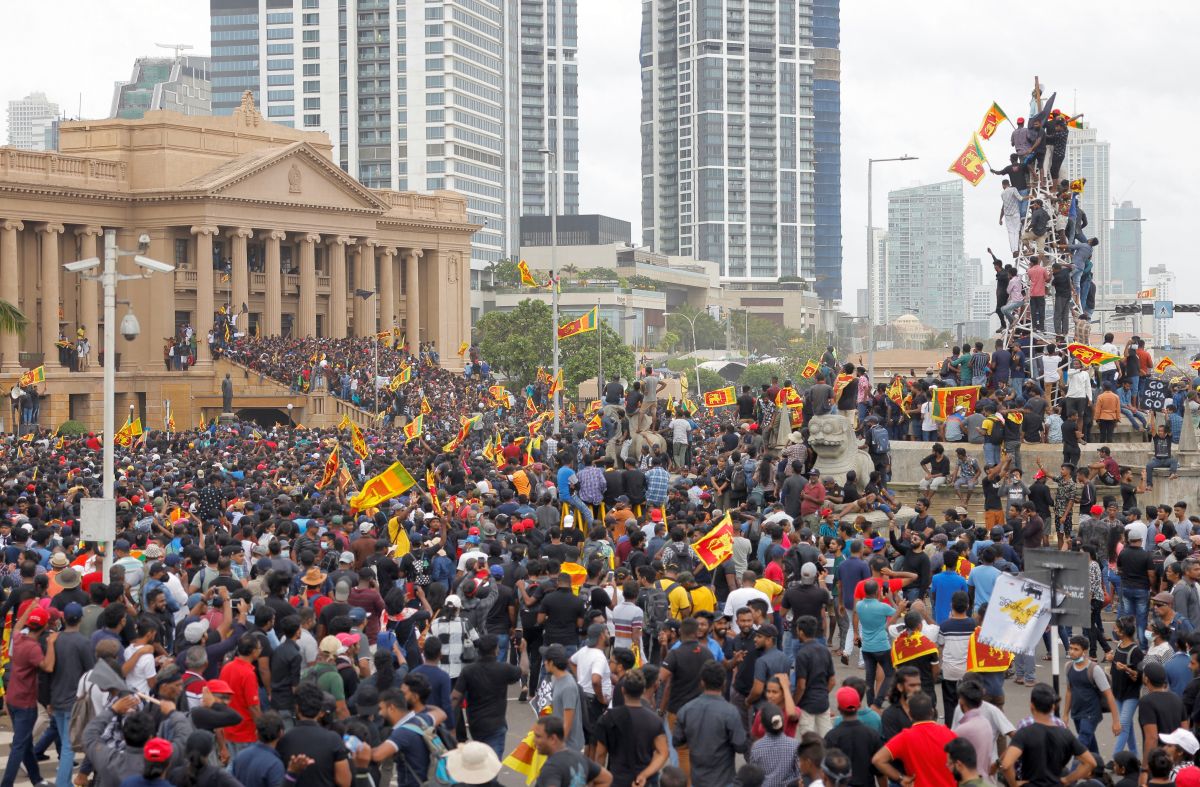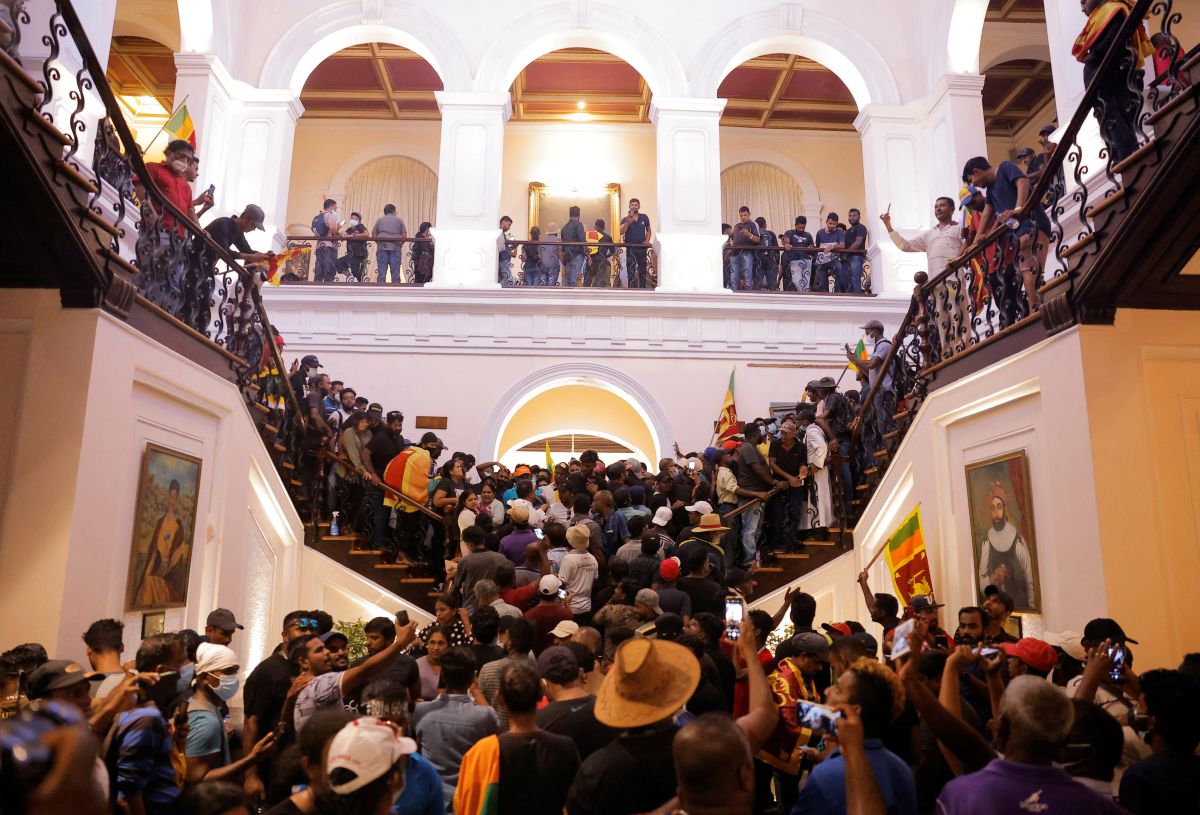Thousands of irate anti-government protesters in Sri Lanka on Saturday stormed into embattled President Gotabaya Rajapaksa's official residence in central Colombo's high-security Fort area after breaking the barricades, as they demanded his resignation over the island nation's worst economic crisis in recent memory.

At least 30 people, including two policemen, were injured in clashes between security personnel and protesters – some of them holding Sri Lankan flags and helmets - who had gathered in large numbers in the Fort area, demanding President Rajapaksa's resignation.
Rajapaksa, who was facing calls for resignation since March, was using the President's House as his residence and office since protesters came to occupy the entrance to his office early April.
According to sources, the President had been moved out of his residence on Friday, in anticipation of Saturday's protests. His whereabouts was unknown as protesters have now occupied both his office and official residence.
A group of his own parliamentarians have addressed a letter to him urging him to step down and appoint a new Prime Minister and an all-party government.
According to a viral video on social media, a VIP motorcade has reached the Colombo international airport where a SriLanka Airlines aircraft was parked.
Amid the turmoil, Prime Minister Ranil Wickremesinghe on Saturday summoned an emergency meeting of all political parties and also requested the speaker to summon parliament, a statement from his office said.
The anti-government protests in April forced the resignation of prime minister Mahinda Rajapaksa, the elder brother of President Rajapaksa, in May.

Protesters who climbed the walls of the President's House are now occupying it without damaging any property or indulging in acts of violence.
Video footage from inside the building showed hundreds of protesters packing into rooms and corridors, while hundreds also milled around the grounds outside.
Some video clips showed scores of people taking a dip in the presidential palace pool.
At least 30 persons, including two police officers, were injured during the ongoing protests and were admitted to the National Hospital in Colombo.
Earlier, the police fired tear gas at two access roads to the President's House -- Chatham Street and Lotus Road, but the defiant protesters continued unabated.
The protesters also clashed with the railway authorities at provincial towns of Galle, Kandy, and Matara as the demonstrators forced authorities to operate trains to Colombo.
Large contingents of police, special task force, and the Army had been deployed around the area.

The organisers of the movement ‘Whole country to Colombo' said people were walking from the suburbs to join the protesters at Colombo Fort.
Protesters said they will not relent until Rajapaksa quits the presidency.
Police had earlier lifted the curfew imposed in seven divisions in the country's Western Province, including Colombo, ahead of the planned anti-government protests, after coming under sustained pressure from top lawyers' associations, human rights groups, and political parties.
The curfew was imposed in seven police divisions in the Western Province, which included Negombo, Kelaniya, Nugegoda, Mount Lavinia, Colombo North, Colombo South, and Colombo Central with effect from 9 pm on Friday night until further notice.
The Bar Association of Sri Lanka protested the police curfew, terming it “illegal and a violation of fundamental rights”.
The body cautioned that the curfew intended to stifle freedom of expression and dissent, which would gravely harm Sri Lanka's economy and its social, political, and international standing.
The Human Rights Commission of Sri Lanka had called the police curfew a gross violation of human rights.

The police curfew was imposed to quell the weekend protest rally march to Colombo from around the country planned over the weekend by religious leaders, political parties, medical practitioners, teachers, civil rights activists, farmers, and fishermen demanding the resignation of the President as well as Prime Minister Wickremesinghe.
They blame Rajapaksa for the country's economic malaise, the worst since independence in 1948.
Sri Lanka, a country of 22 million, is under the grip of an unprecedented economic turmoil, the worst in seven decades, crippled by an acute shortage of foreign exchange that has left it struggling to pay for essential imports of fuel, and other essentials.
Meanwhile, US Ambassador to Sri Lanka Julie Chung on Friday urged the country's military and police to allow peaceful protests.
“Violence is not an answer... Chaos & force will not fix the economy or bring the political stability that Sri Lankans need right now,” she tweeted.
Political and economic instability could potentially derail Sri Lanka's much-awaited USD 3 billion bailout package from the International Monetary Fund (IMF), warned analysts.
Last week, Wickremesinghe announced in Parliament that Sri Lanka would present a debt restructuring programme to the IMF by August to secure a bailout package while underlining that the negotiations with the global lender were more complex and difficult than in the past because the country was “bankrupt”.
The country, with an acute foreign currency crisis that resulted in foreign debt default, had announced in April that it is suspending nearly USD 7 billion foreign debt repayment due for this year out of about USD 25 billion due through 2026.
Sri Lanka's total foreign debt stands at USD 51 billion.





